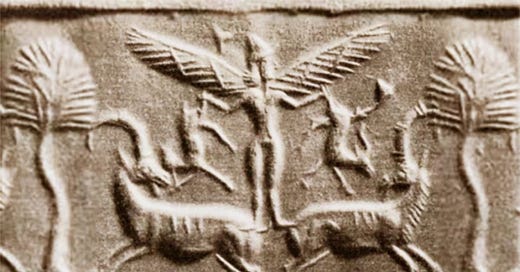Gnosis is always personal and often unverified, though it remains the surest path to legitimate practice. While one individual cannot apply their experiences across the board to others as an overlay or an assumption, they can and should apply them to their own practice, as gnosis is a means of communication between the self and the spirits. A personal practice is a universe unto itself and will be unique by it’s inherent dynamic virtue. As it should.
In my own practice, some gnosis that has been rather persistent and profoundly liberating has finally settled in as Reality for me, and as such, I aim to share it as an open door to contemplation and, perhaps, instances of gnosis being triggered in the individual reader.
When it comes to beings who are incomprehensible to us while we are living out our human stories, the forms which arise as a co-creative manifestations between aspects of incomprehensible and ancient beings and the lattice matrix of the collective of local human minds, their culture, and the land and place in which they live and by which are intimately entangled and transfigured, are the very forms we call gods. But these are forms, expressions through which aspects of larger beings may interact through the veil. The beings themselves are likely too vast to fit into any one of these co-created forms, though the allowance varies through time and culture.
Take Asherah, for instance. Also known as Astarte, Ishtara, Inanna, and by many other names, she was the most consistent deity in the middle east for a few thousand years, always the consort of whatever masculine being was head honcho at any given time. She was a mother goddess displaying all the motherly aspects, depicted in the act of nursing wild animals, riding lions, and worshiped via trees and wild places. Even after Yaweh was declared the one and only god, she persisted upon the home altars of Israelites well into the second temple period.
The other aspects of Asherah had to do with the empowered feminine, a probably long line of priestesses who were almost entirely erased from biblical canon, and the mysteries of sacred sexuality. The concept of feminine wiles cannot be more perfectly captured than they are in the story of Inanna and the God of Wisdom, in which she tricks her father Enki into getting drunk, losing his better judgement, and bestowing upon his daughter a near monopoly of godly powers.
This is exactly the sort of clever, strategic genius that, when coming from an intelligent and determined woman, terrifies men in positions of power. It is no wonder that she had no place in the Abrahamic monotheist machination.
That is, until the being that is Mary allowed for all those silenced and exiled goddesses to flourish in new forms despite the church’s efforts to squash Marianolatry.
However even within this victory, the full glory of such a being simply couldn’t fit in the new restricting clothing. The character and being of the old Queen of Heaven could only resonate with certain aspects of the new Queen of Heaven. The sly, sexual, and cunning aspects of this ancient goddess had less resonance within the Marian current, and thusly those still-exiled aspects eventually found their home in the grimoires under a distorted version of one of her previous names; Astaroth. Even the name itself was altered to mean “harlot”, displaying the intensity of disgust and fear men hold for a sexually liberated and empowered female.
What I see happening here is a split, not in her being, but simply in the doors which are in the world that open to her interacting therein. Part of her could carry on in Mary and continue to have relationships with humans, while the other aspects were quite literally demonized. This did no harm to the Queen of Heaven, of course. It only bifurcated her portals of interaction much in the same way that you might swear like a sailor and make raunchy jokes around your friends but not around your grandparents.
Drawing from this example, it is my gnosis and I have witnessed, that the multivalent Dark Man, Man at the Crossroads, Horned One, Old One, Bucca, Odin, and Illuminator of Humankind, who has been present in European traditions since long before Abraham, Isaac, and Jacob were even whispers in the wind from a distant land and people, went through a process much like that of Our aforementioned Lady.
But it might not be what you expected.
Stay tuned for more, if you dare.




"The concept of feminine wiles cannot be more perfectly captured than they are in the story of Inanna and the God of Wisdom, in which she tricks her father Enki into getting drunk, losing his better judgement, and bestowing upon his daughter a near monopoly of godly powers."
Doesn't Isis do something similar to Ra? But she poisons him to trick him into giving her his secret name which is the only thing that can cure him.